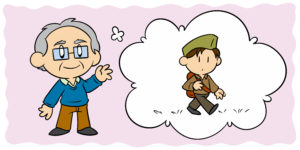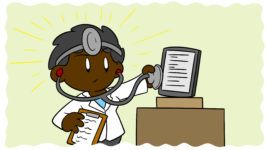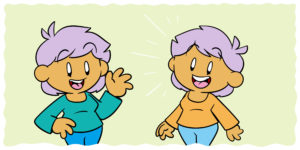The term ‘synecdoche’ is unwieldy, even unfriendly, but it describes a useful literary device that you’re probably already using at various levels of your writing, from the concepts behind your story to the way you phrase certain sentences.
Good synecdoche has a lot of uses, but when it turns bad, it has a uniquely goofy way of screwing up your writing. That’s why, in today’s article, we’ll be looking at what synecdoche is, how it works, and how you can improve the good and avoid the bad.
What is synecdoche?
Synecdoche is a figure of speech where a part of something is used to represent the whole. For example, a person might say, ‘Check out my new wheels,’ using a car’s wheels as a figure of speech that represents the whole vehicle. Similarly, if you get a few ‘hired hands’ to help you with a task, you’re describing ‘workers’ via a specific part of their anatomy, just as calling a businessperson a ‘suit’ is describing them via an article of clothing.
Likewise, if you charge to a credit card by asking someone to ‘put it on the plastic,’ you’re using synecdoche to describe an item in reference to the material of which it’s made, and if you order someone to ‘get your butt out of here,’ their posterior isn’t your sole concern – it’s synecdoche for their entire presence.
Synecdoche has a lot of uses, both in terms of emphasizing and altering meaning. ‘Hired hands’ implies manual work in a way that ‘hired workers’ might not, while ‘get your butt out of here’ reduces a person to their backside, making it even more deliberately dismissive.
Less commonly, synecdoche can describe the reverse process – using a larger component to describe a part. For example, if Brazil win the World Cup, it’s not as if the whole nation actually played, and when we say that humans invented fire, we don’t mean that every member of the species was sitting around experimenting with flint.
Synecdoche has an odd relationship with another technique called ‘metonymy.’ With metonymy, a word or phrase is replaced with a related concept. For example, if someone says they ‘like your ride,’ again referring to a car, the ride isn’t a component part of the car, so this isn’t technically synecdoche. Likewise, if you offer to ‘give someone a hand,’ it may not actually involve your hands at all – the term used is metaphorical rather than a literal component.
As may already be apparent, the lines between synecdoche and metonymy are often blurred, and some argue that synecdoche is just a specific type of metonymy. If you’re a grammar nerd, feel free to dig deeper, but all you need to know is that synecdoche usually refers to describing something using one of its component parts.
It’s worth making this distinction, because while literal word-for-word synecdoche is a useful writing device, it’s a technique that can also have deeper value to your writing.
Conceptual synecdoche
In terms of phrasing, synecdoche has many uses, and we’ll revisit some of them in a moment, but it’s worth establishing the ways in which synecdoche digs deeper than mere wordplay. Synecdoche isn’t just saying a part when you mean the whole, it’s depicting a part as a way of discussing the whole.
If, for example, you wrote a story about deforestation but focused on one tree, you’d be using synecdoche, and this would open up options for more emotive writing. The same is true of characters who are used to represent larger groups; you get a deep emotional connection to an individual and the profundity of a larger statement.
Books like The Boy in the Striped Pajamas, while depicting fully fleshed-out characters, also describe vast historical moments, and the loss of an individual can personalize far bigger, less emotionally comprehensible events.
If it’s starting to sound like all writing involves a little synecdoche – specific events speaking to larger experiences, individual characters demonstrating wider human truths – then perhaps that’s the case. In her MasterClass lecture series (which we’ll be reviewing here soon,) author Joyce Carol Oates asserts that synecdoche is at the core of artistic expression.
All art is based on this principle of synecdoche. In other words, you’re choosing and selecting. I once wrote a novel about Marilyn Monroe, and Marilyn Monroe had a number of miscarriages, and she was in these two orphanages and a number of foster homes, so when I wrote about her, I only wrote about one miscarriage, I wrote about one foster home and one orphanage, because if you’re writing about six foster homes, or six miscarriages, you can’t really make that powerful. So this art of synecdoche, or choosing and selecting, one stands for the whole, that is the principle of all art.
– Joyce Carol Oates, ‘Lesson 2: Principles of Writing Short Fiction’, MasterClass
Oates has a point, and not just in relation to fictionalizing real events – even wholly fictional elements tend to stand for more than their literal selves. Indeed, this can happen by accident if you’re not careful. If, for example, your story includes just two people from a given group and they’re both awful people, it’s easy for readers to assume you intend them as synecdoche for that group as a whole. If humans are good at one thing, it’s spotting patterns, and imprecise synecdoche can often leave you making more of a statement (or just revealing more of your assumptions) than you intend.
There’s also a risk of simplifying complex events in ways that actually betray reality. For example, many people with addiction issues relapse multiple times when in recovery, but this type of gradual, halting progress can be less satisfying in fiction, so authors tend to use the synecdoche of total recovery or singular relapse, painting a picture that’s less realistic and can even influence real-world attitudes. In short, if you’re employing synecdoche, it’s worth really thinking about what wholes your parts are describing.
The good news is that this type of synecdoche can be an incredible tool when used wisely. Synecdoche helps personalize larger concepts and render big ideas more manageable for the reader. Books like World War Z, Chuck Palahniuk’s Rant, or even The War of the Worlds– stories that bring together the disparate accounts of individual characters – can create a sense of a larger, more complex story than books that actually try to depict the whole of the event. As characters scrabble to survive the Martian invasion of The War of the Worlds, the reader is given the impression of all of humanity going through the same experience; they’re asked to reflect on what they’d do in the same circumstances, and this is so much more compelling than bigger-picture accounts of the same events.
Ask how you can use synecdoche in both your individual scenes and your plot to emphasize the elements of your story that would benefit from this kind of symbolic representation.
Good and bad synecdoche
Conceptual synecdoche is useful on the large scale, but synecdoche is also relevant on a word-by-word basis. As with larger concepts, summarizing a whole through its parts can make for a more compelling way to express an idea. In the following extract, a character’s physical presence is expressed through the synecdoche of his facial hair. It’s a unique turn of phrase that takes a generalized experience and makes it both more specific and more visceral.
At midnight I went on deck, and to my mate’s great surprise put the ship round on the other tack. His terrible whiskers flitted round me in silent criticism.
– Joseph Conrad, The Secret Sharer
Synecdoche is used to similar effect in this second extract, with a component part – a wave – representing a much large whole – the area of ocean. Not only is the visual clearer and more emotive, but it communicates some of the character’s unique perspective as someone who lives on the water, as well as their personal sense of place.
The western wave was all aflame.
– Samuel Taylor Coleridge, ‘The Rime of the Ancient Mariner’
The day was well was nigh done!
Almost upon the western wave
Rested the broad bright Sun
In the right hands, synecdoche can even be used to make something feel larger than life. In the following extract, Toni Morrison breaks down the parts of a body, with each part used to comment on the far larger whole of the human experience.
This is flesh I’m talking about here. Flesh that needs to be loved. Feet that need to rest and to dance; backs that need support; shoulders that need arms, strong arms I’m telling you.
– Toni Morrison, Beloved
Despite breaking the body down into parts, Morrison is actually making a person seem larger than life. To see this in action, consider the same sentiment expressed using the whole:
I need to be loved. Sometimes I need to rest, and sometimes I need excitement. I need support; I need to be held!
Of course, you could reword this to be a little more compelling, but only in Morrison’s version do you get the sense of the vastness of the human experience, and she does this by using the synecdoche of the body’s component parts.
So, that’s good synecdoche, and emulating it will help your writing – by finding a more exciting way to communicate an idea, by subtly replicating character outlook, by expanding an idea to better explore its intricacies – but bad synecdoche also exists.
Bad synecdoche tends to occur when used without a compelling reason. Here, authors want a different way to say something, but the method they choose doesn’t add anything. In such cases, what’s left is unusual terminology that complicates an idea without any visible justification. For example, if a character says, ‘My feet walked down the dark alley,’ they just sound bizarre. Without any added sense of meaning or impact, the reader is left considering why the character seems to consider themselves separate from their own feet.
One of the main reasons this happens is mere clumsy description – it’s common for authors to write ‘my shoulders shrugged’ rather than just ‘I shrugged’ – but this is the type of clumsiness that, once written, your brain will glide over. You’ll never quite notice how oddly such turns of phrase read, but your readers will. It’s something you’ll have to deliberately search out in your writing, because it’s perfectly suited to slip past your notice otherwise.
A further complication is that synecdoche is already common in how we discuss our bodies. When we’re disappointed, our hearts fall, and when we’re angry, our fingers itch. Because of this, the boundary between what falls flat and what works can blur and even shift depending on the project. For example, is the sentence, ‘My eyes searched the page, looking for a clue,’ a normal piece of writing or a strange use of synecdoche? Presented alone, it’s easy to see why it would read strangely – why is the character disassociating from their own eyes? – but nestled in a larger paragraph, it’s the kind of line that will tear one out of ten readers out of their investment in the story and make them feel silly for being sucked in by such flawed writing.
The same is possible with more symbolic synecdoche – if you use a single entity to represent a group, or a moment to represent an age, there’s a possibility that the attention you’re lavishing on such a specific point will read strangely if the reader isn’t engaged by the symbolic intent. When the reader doesn’t take your intended symbolic meaning, they encounter the moment of synecdoche as a bizarre aside that distracts them from the main story and makes them doubt your abilities and intent. What was with that random character who was really important for two minutes and then vanished forever?
It’s hard to represent this with a literary extract, since it’s the sense of unnecessarily wasted time that makes this so unfortunate and we only have so much space, so let’s turn to a cinematic example. In superhero movie The Avengers, actress Ashley Johnson plays ‘Waitress.’ Johnson appears in a few scenes as one victim of a citywide alien assault and is briefly interviewed on the news at the movie’s conclusion. The clear intent is that she works as synecdoche for the citizenry of New York – a person who feels real but whose experiences speak to the wider risk and fear going on off-camera, clarifying the human stakes of a fantastical conflict.
The problem is that Johnson appears at just the wrong frequency – too often to work as a symbolic presence, too rarely to constitute a true character. Instead, the audience feels cued to expect more – she attracts attention, so she must be going to do something – and then confused when she doesn’t deliver.
So, what went wrong? Well, in this case, the answer is simple: a scene fleshing out Johnson’s character was cut from the cinematic release. With this scene, she’s just individual enough for the synecdoche to succeed – the viewer is cued to understand why we keep seeing her experience of the conflict – but without it, she’s a distracting presence who seems to be pointing to something that never fully materializes.
The best way to avoid this effect is to run your writing past alpha or beta readers and to be willing to kill your darlings. When synecdoche outgrows its proper place, it tends to do so because a writer enjoyed writing a diversion a little too much, treating it as an opportunity to indulge in some purple prose. Of course, sometimes it makes sense to go the other way; if an aspect of your story outgrows its intended use as synecdoche, maybe it deserves to graduate to something more.
The parts and the whole
Used correctly, synecdoche runs the gamut from a mildly useful turn of phrase to a core aspect of artistic expression. Sure, sometimes it outgrows its purpose and you need a keen eye to prune it back, but understanding what synecdoche does for your writing is the best first step to gaining this skill.
What are your favorite instances of synecdoche in your and others’ writing? Let me know in the comments, and check out Why More Authors Should Harness The Power Of Conceit and Oxymoron, Tautology, Or Malapropism? What You Need To Know for more great advice on similar writing devices.





